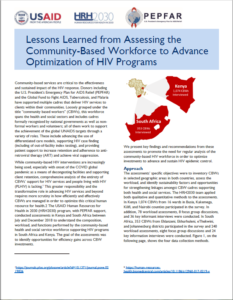04 Dec Lessons Learned from Assessing the Community-Based Workforce to Advance Optimization of HIV Programs
The COVID-19 pandemic has exacerbated countries’ human resources for health challenges and emphasized the importance of having a well-prepared and adequate workforce to not only respond to pandemic needs but to maintain essential services including those for HIV. Community-based services have been critical to maintaining the HIV response. While donors including PEPFAR and the Global Fund to Fight AIDS, Tuberculosis, and Malaria have supported multiple cadres that deliver HIV services to clients within their communities—loosely grouped under the title “community-based workers” (CBWs)—comprehensive analysis of the entirety of CBWs’ support for HIV services and people living with HIV is lacking.
HRH2030, with PEPFAR support, conducted assessments in Kenya and South Africa between July and December 2018 to understand the composition, workload, and functions performed by the community-based health and social service workforce supporting HIV programs. As the final brief, Lessons Learned from Assessing the Community-Based Workforce to Advance Optimization of HIV Programs illustrates, assessing the availability, roles, and performance of CBWs provides important insights into their contributions to achieving the 95-95-95 targets, and illustrates where efficiencies in programs supporting CBWs could be gained by:
- Examining roles across cadres to align CBW classifications and inform opportunities for consolidated efficiencies
- Looking for opportunities to integrate workload and time standards as basis of performance benchmarks
- Looking at how effectively training is building capacity of CBWs to perform key HIV services
- Reviewing and identifying human resources practices to best support CBWs performance
- Strengthening coordination and linkages within and across CBW cadres.
Approach
The assessments’ main goal was to identify opportunities for efficiency gains across CBW investments. The specific objectives were to inventory CBWs in selected geographic areas in both countries, assess the workload, and identify sustainability factors and opportunities for strengthening linkages amongst CBW cadres supporting both health and social services. The HRH2030 team applied both qualitative and quantitative methods to the assessments. In Kenya 1,074 CBWs participated in the survey. In addition, 78 workload assessments, eight focus group discussions, and 36 key informant interviews were conducted. In South Africa, 353 CBWs participated in the survey and 240 workload assessments, eight focus group discussions, and 24 key information interviews were conducted.
Associated content:
How Assessing the Community-Based Workforce Can Help to Optimize HIV Programs
Country: Kenya, South Africa
Resource Type: Technical Brief
Topic: HIV/AIDS
DOWNLOAD






